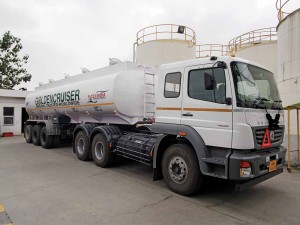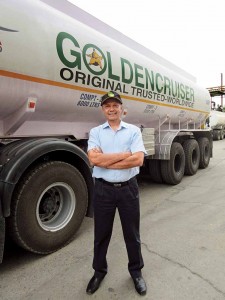S-CCI India is keen to increase its exposure in the CV sector by manufacturing diesel exhaust fluid.
Story by:
Anirudh Raheja
Specialising in the manufacture of engine coolants, S-CCI India Private Limited, is getting into the manufacture of Diesel Exhaust Fluid (DEF) to increase its reach in the Indian CV market by manufacturing DEF at its Chopanki plant at Bhiwadi. The company is eyeing a pie of the market that is estimated to be 4576000 kilo litre and growing. As part of an initial investment in DEF, S-CCI will be investing Rupees five-crores in a phased manner to set up a capacity of 10,000 kilo litres. With the number of SCR equipped CVs expected to grow rapidly as BSVI emission standards are implemented in 2020, S-CCI India is looking at a rapid growth in the segment. It is keen to leverage its existing network as well as those that come in as part of the expansion it is carrying out, to achieve a higher market reach as far as DEF is concerned. Established in 1985 in technical collaboration with CCI Corporation, Japan, to manufacture engine coolants, S-CCI India is closely following the consumption pattern of DEF in India. Typically consumed at the rate of three to five per cent of the fuel quantity, one fill of AdBlue in a separate tank of 40-litre capacity is said to be sufficient for one fill of fuel tank, which is usually 800 litres in a CV. Catering to CV manufacturers like Tata Motors, Force Motors, SML Isuzu, and tractor and off-highway equipment manufacturers like TAFE, Escorts, ITL, Eicher and Komatsu, the company, according to S. K. Singh, Director, S-CCI India, is intrigued by the travel of CVs across the length and bredth of the vast country.
Confident of the growth potential of DEF, S-CCI India is also looking at increasing its reach of coolants for CVs. While both the initiatives are expected to further strengthen the company’s bottomline, S-CCI India is closely observing the changes in engine technology dictated by the tightening emission regulations. “Unlike earlier, OEMs have begun asking for coolants of specific nature. This is linked with the change in engine metallurgy and the need for CVs to spend more time on the road,” expressed Singh. Demand for coolants that best suit the job is rising. Reducing the tendency to boil over with the use of Mono Ethylene Glycol (MEG), and resist corrosion, coolants in CVs are subject to higher stress according to Singh. MEG cannot be used in its concentrated form since CVs have higher operating temperatures. Its heat transfer properties are not as good. MEG is used with 30 to 50 per cent water since it has a better heat transfer property. Changing expectations regarding coolants have reached a level where they are expected to last the lifecycle of the vehicle. Earlier, a coolant had to be changed at an interval of 10,000 km. Developing a coolant (L415) for MAN Trucks India that has a life span of five lakh kms, CCI, said Singh, has won the approval of Daimler.
Validation and manufacture
A combination of various chemicals, including anti-corrosive elements and boosters, stress is laid on achieving a balance where the coolant is neither acidic nor alkaline in nature. It is essential to achieve validation, which could take up to two years according to Singh. “Certain lab tests can measure and prevent chemical depletion. This helps to gauge the life of the coolant,” explained Singh. He drew attention to restrictions imposed by automakers on the use of chemicals. This is claimed to be in the interest of complying with regulations. Pointing out a blanket ban for carcinogenic chemicals, mercury and cadmium, Singh revealed that automakers give coolant manufacturer the freedom to develop better products. “Competition is fierce, and it is important to be aware of what the competitors are up to,” he said.
Working towards building a plant at Gujarat, S-CCI India is planning to invest Rs.15 to Rs.20 crore in a phased manner. Once operational, the Gujarat facility will complement the company’s two existing facilities at Chopanki and Sitarganj respectively. The Chopanki facility has a capacity to manufacture 15,000-kilo litre of coolants, and nine thousand kilo litres of brake fluid. The plant employs 125 people. The Sitarganj plant has a capacity to manufacture three thousand kilo litres of coolant, and two thousand kilo litres of brake fluid. The Chopanki plant is operating at 65 per cent capacity according to Singh. Capacity, he said, could be increased as per the demand. Pointing out that 60 per cent of the CV business moves on a small fleet size of up to two trucks, Singh averred, “The way the segment is stagnating is not very healthy. It is not a healthy sign for a growing economy.” Spending up to two per cent of its revenue on R&D activities, S-CCI India is dependent on CCI for broader technological updates. The test lab within the Chopanki plant tests for Ph value, conductivity, tendency to foam, and more. The lab is equipped with test equipment like conductivity meter, foaming tendency tester, reserve alkalinity tester, gas chromatography, melting point analyzer, brake fluid rubber swelling tester and corrosion tester for brake fluids.
New launch
S-CCI India recently launched a long life anti-freeze coolant called Extreme. It can sustain temperatures of up to -36 degree Celsius. Stated Singh, that such intense temperatures are often the case in Europe. “A litre of coolant when mixed with three litres of water leads to a mixture that performs up to -7 degree Celsius. Addition of water over a period of time reduces the change interval from three years to two years as the anti-corrosive properties of the coolant decrease,” Singh said. Stressing upon companies changing their preferences quickly, he opined, “Over co-branded products, OEMs are opting for coolants that flaunt their brand name. These are built to their specifications.” With a rise in awareness for high quality products, Singh mentioned that OEMs are demanding high life coolants. When it comes to MNCs, S-CCI India is leveraging CCI’s relations. The company is thus looking at clinching a deal with Yanmar Tractors, which is entering India, by leveraging CCI’s relation with the tractor manufacturer.
The aftermarket accounts for 15 per cent of the company’s volumes. The challenge, according to Singh, is counterfeit products. To overcome the challenge, S-CCI India has placed a sales team that regularly communicates with mechanics. The company has 150 distributors that network with 20,000 retailers across the country. Work is on to increase the presence in the North East markets according to Singh. Looking up to GST as one of the biggest reforms, Singh expressed that there is a need for an efficient redressing mechanism. “If it is efficient and fast, GST will succeed. If there is harassment, it will create unhappiness,” he mentioned.
Fleet for quality
To ensure quality and eliminate the risk of contamination, S-CCI India has invested in its own fleet. Made up of 32 tankers and trucks, the company has at its disposal 3000 to 25,000 litre of bulk space. This space is efficiently utilised to transport brake fluid, which is hygroscopic in nature. Care is necessary therefore. Only on recommendation does the company supply through third party operators. The risk of contamination is very high, averred Singh. The tanks of bulk carriers are often not washed properly after doing a round of hydrogenated oils, fatty acids, and edible oils. S-CCI India carries out supply in two ways – bulk tankers and containers for the OEMs, and small packs for the dealers and the aftermarket. “Dealers do not buy in large packs. Companies do not allow them to buy in large quantities. At the other end, companies buy in bulk quantities and then supply them to the dealerships,” Singh mentioned. Designed specifically to address the needs of OEMs, S-CCI India has procured stainless steel tankers for brake fluids as the fluids they tend to react with painted surfaces, and can lead to blisters. Since OEMs have different storage capacities, the movement of tankers happens as per the demand. “After pouring, we seal the tank and give it a serial number. At the receiving end, the same number is matched to check the authenticity,” said Singh. In case the seal is broken, that compartment is not off loaded. A sample is taken out, tested and offloaded only after it is found to be genuine.





























